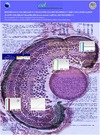Identificador persistente para citar o vincular este elemento:
https://accedacris.ulpgc.es/jspui/handle/10553/12414
| Título: | Importance of dietary n-3 hufa for eye development and cone formation along gilthead seabream sparus aurata larval development. | Autores/as: | Roo, Javier Socorro Cruz, Juan Antonio Izquierdo, Marisol Hernandez-Cruz, C.M Valencia, Antonio |
Clasificación UNESCO: | 251092 Acuicultura marina 240110 Histología animal |
Palabras clave: | Larva Dorada Sistema visual |
Fecha de publicación: | 2000 | Resumen: | Being fish larvae visual feeders, vision plays an important role in larval orientation at first feeding (Blaxter, 1986). Larval trophic behaviour is closely related with the development of the visual capacity, which directly depends on retina organogenesis. In sparids, such as Pagrus major (Kawamura, 1984) and Pagrus auratus (Pankhurst, 1996), the most important changes in the eye structure occur along the lecitotrophic stage as a preparation for prey capture. Neuringer et al.,(1988) has established a critical role for n-3 polyunsaturated fatty acids and, particularly docosahexaenoic acid (DHA) in neural and retinal tissue functions in mammals. Similarly, in larval fish there is a high demand of DHA to form nervous membranes. Bell and Dick (1993) found photoreceptors in the eye, rods and cones accumulate and selectively retain DHA in external segments.Bell et al. (1995) found that feeding juvenile herring a DHA poor Artemia diet during the period of rod development resulted in impaired vision at low light intensities, when rod vision is essential. | URI: | https://accedacris.ulpgc.es/handle/10553/12414 |
| Colección: | Póster de congreso |
Visitas
72
actualizado el 13-abr-2024
Descargas
85
actualizado el 13-abr-2024
Google ScholarTM
Verifica
Comparte
Exporta metadatos
Este elemento está sujeto a una licencia Licencia Creative Commons

